Here's how to digitize your documents the easy way and find the right scanner for your needs.
Converting your documents from physical to digital makes them easier to send, store and retrieve, but you need the right device to make the digitization process as painless as possible. If you're wondering how to scan from printer to computer, we're here to help at every step of the process.Speaking of steps, the very first one is to make sure your printer has scanning capabilities. If it does, we'll introduce you to how to use it with your computer to start scanning documents. If it doesn’t, don’t worry. The following steps will work just as well with a dedicated scanner. And if you don’t have a scanner on hand, we’ll lay out some key features to look out for when choosing one for your home office or small business.
Got something else that needs scanning? Check out our comprehensive guide, "How to Scan Just About Anything."
How to scan from printer to computer on PC or Mac
If you have some documents you'd like to digitize and want to know how to scan from printer to computer, you first need to make sure your device is a combination printer/scanner. If you're not sure, start by consulting the original documentation for your printer to see if it references any scanning capabilities. If the documentation isn't readily available, try punching the device name and model number (often found on a sticker on the rear of the device) into a search engine.
The next few paragraphs and bulleted lists will help you start scanning, whether you’re using a multifunction device or a dedicated scanner.
If your computer is a PC with Windows 10, these steps will show you how to scan from printer to computer. Skip to the next list if you're using a Mac.
- Make sure your printer is connected to your PC and turned on.
- Open the taskbar by pressing the Windows key on your keyboard, then type “Windows Scan,” and open the app.
- If your computer does not already have Windows Scan installed, download the official app for free from the Microsoft store.
- Place the document you would like to scan in the document feeder tray or flatbed, depending on the type of device you have.
- On the Scan page of Windows Scan, follow these steps in order.
- Select the scanner you want to use from the Scanner field.
- Select the device location you want to scan from in the Source field.
- Select the file type you would like to save the document as under File type. JPEG is a good default for most documents.
- Select Show more, then Save file to and browse to the location on your computer where you want to save the scan. The default location, “Scanned Documents,” should work fine in most cases.
- Select Scan to scan your document.
- After your document has been scanned, you can select View to perform small image editing tasks if desired, or simply Close to save the image.
If your computer is a Mac, follow these steps steps to start scanning.
- Make sure your printer is connected to your Mac and turned on.
- Place the document in your device's document feeder or flatbed.
- Select the Apple menu, then System Preferences, then Printers & Scanners.
- Select your printer in the list on the left, then click Open Scanner on the right.
- You may need to click Scan on the right before you can click Open Scanner.
- If you are using a flatbed rather than an automatic document feeder, make sure that Use Document Feeder is not selected if present.
- Set your scanning options.
- Choose the type of image being scanned with the Kind pop-up menu.
- Choose the size of the scanned item with the Size pop-up menu.
- Choose where to save the digital version with the Scan To pop-up menu.
- If your device supports duplex scanning, select Duplex to scan both sides of the document at once.
- Click Scan.
If these steps don't work for you, you may need to set up or reinstall your device. Consult the printer manufacturer's instructions for more details.
Did you know?The RICOH C125 MF printer also includes high-quality scanning, fax, and copier functionality in a single, professional package.
Essential features for multifunction devices and dedicated scanners
Whether you need a dedicated scanner to supplement your current setup or you’re looking for a single device that can do it all, the desired result is the same: quality digital duplications of your physical documents and images. Even with the functional differences between models, there are a few features that no scanner should go without.
Ease-of-use
Many modern scanners and multifunction devices are built to make document digitization as easy as possible. Look for a model that offers one-button scanning, as well as software to make the most of its capabilities with minimal user intervention.
Reliability
Your chosen device should be able to handle whatever you throw at it, whether you’re only scanning a handful of documents or need to use it around the clock. Look for devices that offer ready access to replaceable components, and consider options with robust warranty and replacement programs to minimize downtime.
Did you know?PFU America’s Advance Exchange program offers overnight product replacement for any device that cannot be repaired through technical support to get you back up and running fast.
Quality
Scanned images and documents should be as legible and detailed as their physical counterparts. A good minimum resolution for digital versions of text-based documents is 300 dpi (dots per inch). If you plan on printing larger physical versions of images that you’ve scanned, look for devices that offer at least 600 dpi. This may will help minimize visual artifacts and other reproduction errors.
Speed
When you need to digitize more than a document or two at once, you'll be glad to have a scanner that can quickly tackle multiple documents in a row without user intervention. Look for a scanner with automatic document feeder capabilities to speed up and simplify your workflow.Our recommendation: RICOH Printer C125 MF
Need to do it all in a single device? Look no further than the RICOH C125 MF color laser printer. In addition to generating professional prints at speeds of up to 26 color pages per minute, the C125 MF can easily scan documents and images at up to 1,200 dpi, send faxes, and make copies. With a 250-sheet paper tray for prints and a 35-sheet automatic feeder for scans, the C125 MF is built to handle whatever your workday throws at you.
Note: Information and external links are provided for your convenience and for educational purposes only, and shall not be construed, or relied upon, as legal or financial advice. PFU America, Inc. makes no representations about the contents, features, or specifications on such third-party sites, software, and/or offerings (collectively “Third-Party Offerings”) and shall not be responsible for any loss or damage that may arise from your use of such Third-Party Offerings. Please consult with a licensed professional regarding your specific situation as regulations may be subject to change.













